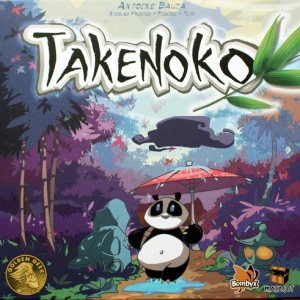
The Emperor of Japan is given the gift of a rare panda by the Chinese Emperor. It doesn’t sound like much of an introduction for a fantastically fun board game, but that’s the very basic setting of Takenoko, a game which sees you building up a beautiful bamboo garden with the help from an irritated gardener.
Still not sold? Keep reading.
Starting with a single patch of garden, it’s up to the players (of which there can be 2, 3 or 4) to expand the garden and grow bamboo for the cute panda to wander round and munch on. The play itself is divided up into two phases in each turn, with turns played out until a certain number of objectives have been completed by one of the players. Unlike some other more complex games though the phases here are as simple as you could hope for: roll a dice, then take two actions. Easy.
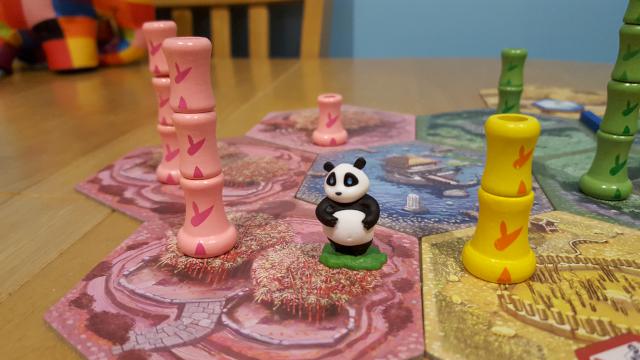
The dice roll decides what the weather will be doing for that turn. Obviously in an intricate Japanese bamboo garden the climate plays a huge part of what happens, and the outcome of the roll will make a difference in how your turn pans out. Brilliantly whether you get sun, cloud, rain or whatever else each outcome is positive to the player who rolled it, there’s no option to receive a penalty from the dice roll, and as such the game can pan out with everyone looking to grow and expand without fear of half of their stuff getting wiped out by a lightning strike or tsunami. It might be that a storm scares the panda, so he “runs off” and you can position him anywhere on the board as a result. Maybe the sun comes out and grants an extra action in the second phase of the turn; there are five possible outcomes, with the 6th side being a “pick your own” result – handy when there’s a specific result you were hoping for.
But it’s the action phase when the most thinking is done, as once you’re here there are several things you can choose to do, with the only provider being that you must do two different actions – that is, of course, unless the dice roll gives you a third as mentioned above, or the wind blows on the dice and you can choose the same action twice, the latter of which can often be far more useful than it sounds. You can choose to draw three hexagonal garden plots from the stack if you want to, at which point you can pick whichever one you want (again, the focus is very much on building the garden up with as few limitations as possible) and position is on the garden. You can’t just plonk it anywhere, it must be adjacent to the starting plot or against two others, forcing your garden to expand fairly evenly outwards and not just in a long line. Each tile has a different colour, and while that can make for some nice pretty looking gardens, the real reason for that comes in the objectives, which I’ll explain in a bit.
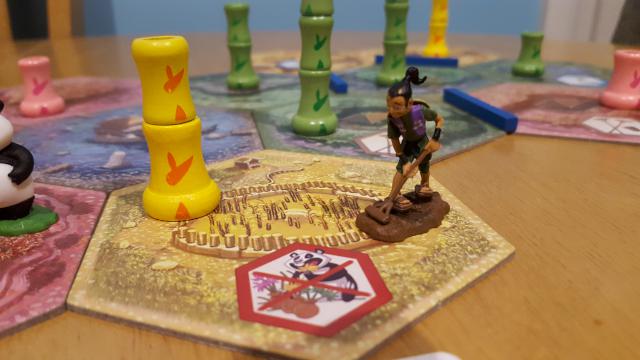
You can also, if you’d prefer, move the panda any distance in a straight line to a new location and eat a section of bamboo currently on that part of the garden, or move the gardener in the same way where he can help to grow the bamboo. This takes on a slightly different idea, with joining colours benefiting from the gardener’s involvement; so for example, if the gardener landed on a pink section of garden, any other joining pink sections also grow some bamboo, just as long as they have water.
That’s right, you need to irrigate your garden with water. While a small number of tiles come with water already on them, most will need to be irrigated by joining them up with the irrigation channels, something you can do as one of your actions. If a tile doesn’t have access to water, the bamboo won’t grow and the panda won’t be able to eat anything if it lands there. It sounds like something that would get in the way, but it’s not at all, it just forms part of a wider strategy which grows as the game progresses. You can even choose to hold onto your irrigation channels instead of placing them on your board, and while that initially seems pointless you’ll soon find that having a small stock of them if a useful tool to have.
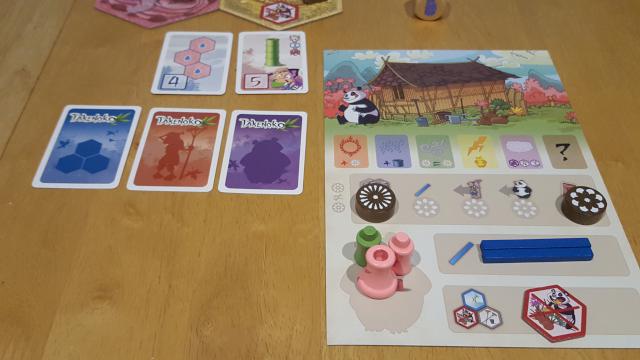
But all of these actions build up towards one thing: meeting these objectives I’ve mentioned a few times. You can hold up to five objective cards at any one time (although taking a new one uses up an action) and each one shows some criteria which you must meet in order to pass that objective. It might be that you have a plot-based objective, whereby you need to have a certain coloured pattern of plots somewhere on the table. Gardener objectives look for certain amounts of bamboo, such as needing three completed stacks of green bamboo on the board, and the panda objectives are all about having certain combinations of eaten bamboo on your game card. Your method of play will vary hugely depending on the cards you have (which, incidentally, the other players won’t see until you’ve completed them) and there’s nothing more frustrating than trying build up tall bamboo plants for one of your gardener objectives only for another play to come and eat half of it to fulfill their own panda task. But that’s where intelligent play comes in – it’s quite possible to trick other players into thinking you’re trying to do a certain thing, only for them to try and sabotage your efforts while inadvertently helping you out. It’s a brilliantly simple system which lends itself to some very close games, and with each completed objective card carrying a points total (added up at the end to find a winner) trying to pick the right order to complete them in is often a good challenge – clever players will even manage to complete several objectives all at once!
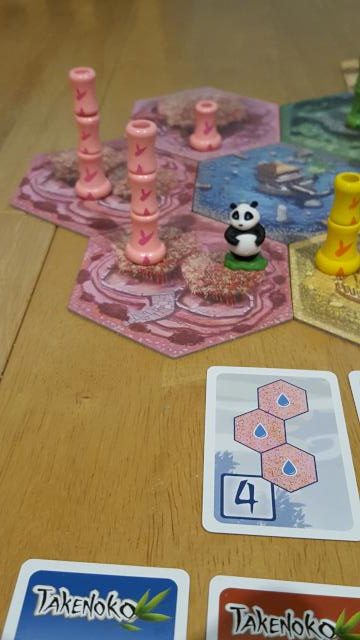
The final thing to help you out is the improvement tokens, earned by getting the cloudy weather from your dice roll and offering some extra function to one of the standard plots. You can prevent the panda from eating from that area, encourage faster bamboo growth or provide water without the need for irrigation. Some plots have these improvements on them already and can really affect the outcome of the game, but the others are open for you to drop improvements onto whenever you want as part of your turn. Keeping these with you until the exact right moment can really make a difference to the outcome of the game.
So it’s probably quite clear that I really enjoyed the game, but I still haven’t mentioned the components of Takenoko. They are, without a doubt, fantastic. Each player has a board to keep track of their own game, but it’s the bamboo, cards, garden plots and fantastic panda and gardener miniatures which stand out as being a really good quality. Bamboo stacks up to 4 sections high, and after a few rounds your garden – which is a shared space for all players incidentally – starts looking genuinely fantastic. The colours, the 3-dimensional game area, the cute panda, the wooden tokens to mark the actions on your board, it’s all brilliant. A game isn’t made from its components alone, but when you’ve got some awesome components accompanying a brilliant game you can’t really get much better.
And if, after all that, you’re still not sold… well I’m out of ideas. This is brilliant.
Takenoko
Available Now, RRP £29.99
Find your local stockist here

Leave a Reply